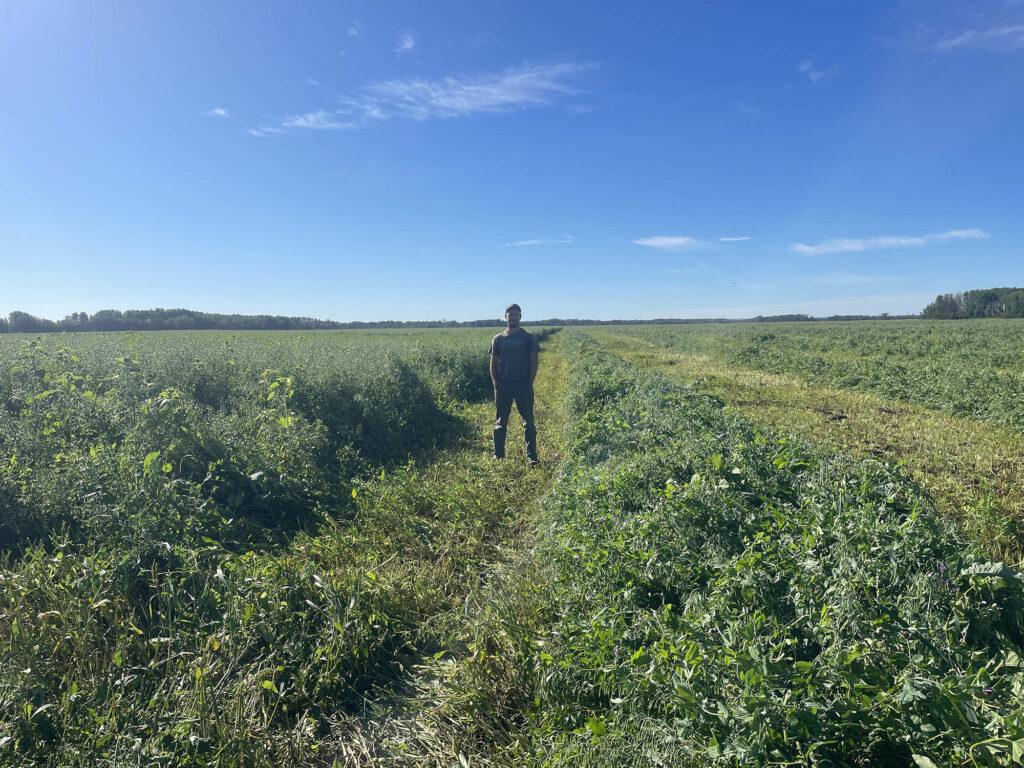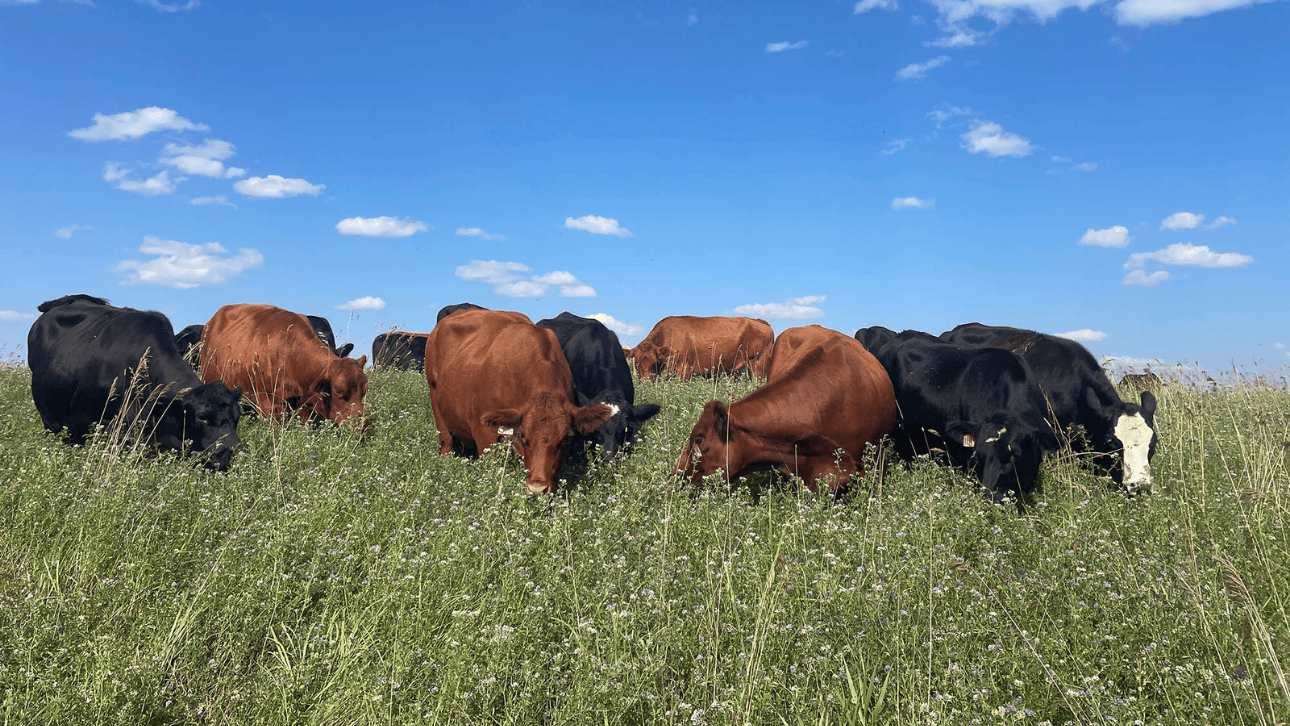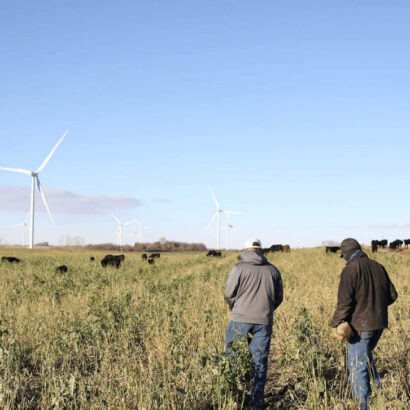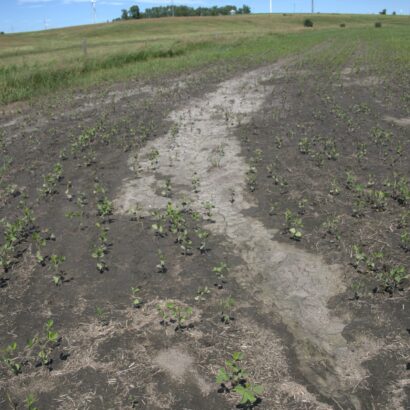FOR IMMEDIATE RELEASE: April 8, 2025
Contact: Laura Vsetecka, laurav@renovoseed.com
(CALGARY, AB, April 8, 2025) – Jolene Noble of Jackknife Creek Land and Cattle in Manning, Alberta says a flexible forage plan will lead to more opportunity with their beef herd this year.
“It’s a very exciting time in the beef industry. We were looking at selling some breds, but with the market the way it is we decided it would be a better choice for us to hang on to these cows and calve them out if we can. And that’s where some out of the box forage strategies come into play. We’re taking some acres out of grain this year and putting them into an annual forage mix.”
Noble shares that this flexibility to shift acres will allow them to have a backup forage source if dry weather prohibits their existing pastures from producing high forage yields.
“If our summer pasture gives out at the end of July or middle of August, we need a bridge to get us to when we were going to start swath grazing. So instead of selling those cows like we would have traditionally, we can just seed another few acres of annual mix and we can summer graze or swath graze it as the season progresses. But now we’re set up to be able to retain those cows, feed them out, wean those calves, and send them to market.”
Justin Fruechte, product expert for Renovo Seed, says Noble is not the only producer he’s heard from who will be making adjustments to their forage plan to accommodate more cattle.
“Because the value of a pound of beef is worth so much, folks can run calves on their annual forage mix and capture enough gain to get a value per acre that justifies not planting a harvestable cash crop. Instead, they’re planting it to a forage,” he shared.
Prioritizing a diverse mix for swath grazing
Although a new seeding of annual forages will tie over Noble’s forage source this year, her grazing plan typically relies on perennial pastures and swath grazing. She shares that when developing a seed mix for swath grazing, she prioritizes a broad mix.
“The first time we tried swath grazing was with straight oats, and it did not work well for us. But since then, we’ve gone to more of a cover crop or polycrop. So, the main workhorses in it are still a spring cereal, but we’ve got forage peas in there, a couple different types of brassicas, and hairy vetch. And then we do throw a few more things in for diversity and nutrition, but also primarily for soil health. We add in a couple warm-seasons like sunflowers, buckwheat, and millet. And we’ll throw in another cool-season like Italian ryegrass, but those will be in a smaller portion compared to the brassicas, cereal, hairy vetch, and peas.”

Noble’s brother, Lee, standing in their custom swath grazing blend. This mix is seeded in late May or early June and cut in late August or early September. The mix will be swath grazed by pairs and yearlings in the fall and winter.
When asked how Jackknife Creek Land and Cattle plans their acres, Noble shares that location and water source are key factors.
“Pretty much any field that is close enough to the home yard and has a water source is something we will swath graze at some point in time. We usually only swath graze one or two years in a row. With a diverse mix like that, you can end up with some weed pressure if you do it year over year, especially because you’re not doing anything in the fall to kill those weeds. But if we rotate out every year or two, that allows for weed control in other years.”
Noble also shares that the forage planting timeline aligns well with the grain side of their operation.
“It’s a little push and pull. Sometimes I want some forage in before the canola acres are seeded, but swath grazing actually is a great fit for that because it’s best if it’s seeded at the very end of May or into June so the oats don’t turn early in August. That way you don’t have to cut it quite as early. It works really well for us.”
Improving herd health with diverse forage mixes
Noble says that feed testing, combined with her own anecdotal evidence, points to diverse mixes leading to high health of the herd.
“We get our feed tested every year, and our protein and energy continue to be high. As high as we need for growing calves, lactating cows, and cows that are at the end of the second trimester by the time we bring them home. Our open rates have improved, too. Our calving interval has tightened up and our calves have never looked as good as they do now.”
She continues, “knock on wood, we haven’t had anything ill on swath grazing in the last five or six years that we’ve been doing it this way with a later weaning date. The extensive system and keeping calves on moms seems to do wonders for the calf health. And because we’re moving them to swath before the quality of the perennial pasture declines, we’re seeing those calves not skip a beat between lush summer pasture and high-quality winter forage.”

Swath grazing blend prior to cutting.
Pre-built mixes from Renovo Seed provide simple solutions
Renovo Seed, formerly known as Union Forage in Canada, offers pre-built, proven to work seed mixes for farmers and ranchers throughout Canada. Noble says she plans to use Renovo Seed’s Green Feed Relay Mix as a forage source, and a holding place for cattle transitioning between pastures.
“We have a small field adjacent to the home quarter that we’ll seed into Renovo’s green feed relay mix. It’s a mix of annual ryegrass, Italian ryegrass, and hairy vetch that we will seed with a forage oat. We’ll take bales off that at the start of August, and then we’ll let that come back and regrow. It makes a great place if we bring the cow herd home and they have to go somewhere for a day or so, they can go there. It’s nice to have a place that they can go and we can just turn them out we don’t have to worry about that group.
###
About Renovo Seed
Renovo Seed leads the seed industry as a visionary in positive land use solutions. Backed by Millborn’s powerful supply chain, Renovo Seed works to improve the resiliency of the land for generations to come with a robust seed lineup and unmatched team of experts who design practical, tailored solutions for farmers, ranchers, and landowners. For more information, visit RenovoSeed.ca.




Discussion
0 Comments